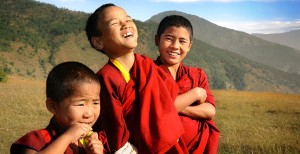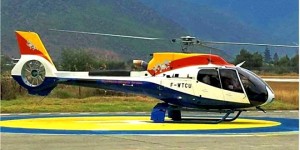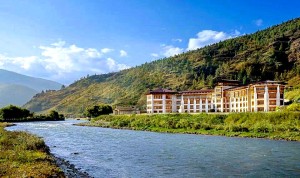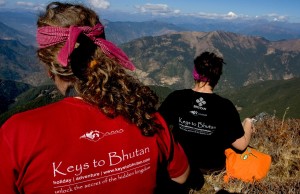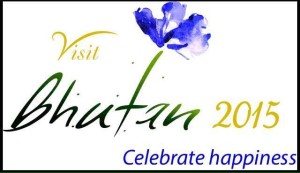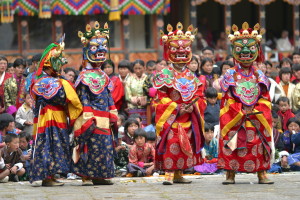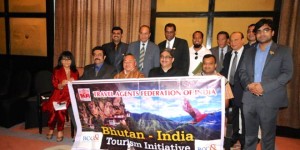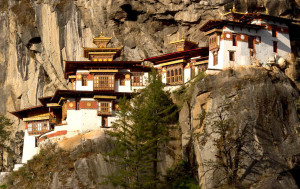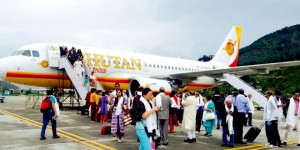Trekking through the Himalayas in Bhutan.
I’m in the prayer hall of Tango Buddhist monastery high on a mountainside in Bhutan, watching as a woman performs chag, ritual prostrations before the Buddha.
Three times she clasps her hands in the prayer position, brings them to the crown of her head, to her throat and then to her heart before folding to a kneeling posture and touching her forehead to the floor.
Chag is one of seven ritual practices known as yoen lak duen pa; the woman is a Westerner. Over the next week it’s a theme repeated with many small variations, foreign visitors spinning prayer wheels, lighting butter lamps, wearing the white khata, Buddhist symbol of purity.

Monks look out of a temple in Tango monastery on the outskirts of Thimphu. Photo: Reuters
“Why do people come to Bhutan?” a guest at dinner in my hotel asks me that night. He’s Bhutanese, a lawyer, and it’s a rhetorical question.
“It has a wonderful topography of mountains and forests and rivers, clean air, small population, but then so does Colorado, so does New Zealand and Switzerland. So why do people come from so far when they could so easily and so much less expensively find all these things closer to home?
Because they come to Bhutan for the culture. Because they sense in Bhutan something that has been lost from their own existence,” he says. “They want to change their lives.”

Mount Jumolhari at 7300 metres, seen through prayer flags from Chele La Pass. Photo: Danita Delimont
The last Himalayan Buddhist kingdom, Bhutan is a world apart, a misty, mystic, sequestered realm of chanting monks, prayer flags and monasteries perched high on sub-Himalayan ridgetops. Known as Druk-yul, “Land of the Thunder Dragon”, Bhutan moves to its own rhythm.
This was the last country to get television, and still, so they say, the last without a traffic light. The sale and distribution of cigarettes and other tobacco products is illegal. The gho, the knee-length robe that is the Bhutanese national costume, is required for men working for the government, schools or the tourism industry.
Most famous is Bhutan’s concept of Gross National Happiness, its unique contribution to the way nations measure their success. Rather than the crude yardstick of Gross Domestic Product, Bhutan gauges its position in the world by the four yardsticks of culture, environment, good governance and economic development. It’s another kind of richness, and viewed through the prism of GNH, Bhutan scores well.

Elderly men in traditional Bhutanese dress are seen at a Buddhist festival in Thimphu. Photo: Reuters
Bhutan offers a masterclass in another way to live, but it’s not for everyone. Bhutan pursues a policy of high-value, low-impact tourism “aimed at attracting tourists who will respect the unique culture and values of the Bhutanese people”, according to the government’s website.
Apart from visitors from India, Bangladesh and the Maldives, every visitor pays an admission fee of US$250 (NZ$380), a figure that deters backpackers and budget travellers. Excluding visitors from the subcontinent, Bhutan laid out the welcome mat to a little more than 50,000 international arrivals in 2013. It’s exclusive, and the high admission price adds to its mystique. It also fosters a clubby elitism among its visitors.
Although it has all the right credentials to become the adventure capital of Asia, apart from white-water rafting on the Pho Chu River and a couple of hardcore treks, the lack of specialist operators and the high cost rules this out as a premium adventure destination. Once you’ve visited a couple of monasteries, admired the sunrise over the Himalayas, shopped for prayer wheels or singing bowls and drunk your fill of butter tea, there’s not an awful lot to do.

A statue of Lord Buddha is pictured at Kuensel Phodrang in Thimphu. Photo: Reuters
Walking, however, is essential, and it’s humbling as well as challenging. Visitors must get used to panting. Paro, Bhutan’s international airport, sits in a valley at an altitude of 2200 metres. Almost exactly the same altitude as Mount Kosciuszko, and, from Paro, just about everything is up.
Walking here takes you into thigh-burning territory, along forest paths where the trees are webbed with wild clematis or old man’s beard, known here as Dakini hair after the female sky dancers who assist Buddhists along the path to enlightenment. The trail will usually deliver you to a monastery, which are pitched high on the mountainsides for reasons of security as well as the essential quality of isolation.

The ParoTaktsang Palphug Buddhist monastery, also known as the Tiger’s Nest. Photo: Reuters
I’m on a high trail climbing towards the pass at Chele La when there’s an almighty howling. One of the dogs that has been accompanying us has invaded the territory of another. “Anger,” says Kuenzang Tobgay, my guide. “One of the three poisons that stands in the way of enlightenment.”
Although my prostrations might be less than perfect, if I can cling to that thought in traffic, in the supermarket queue or next time I’m on hold on the phone listening to inane music, Bhutan will have changed my life for the better.

A boy and an elderly man are seen at a prayer wheel at the National Memorial Chorten in Thimpu. Photo: Reuters
MORE INFORMATION tourism.gov.bt
GETTING THERE Druk Air has daily flights from Bangkok and twice weekly flights from Singapore to Paro, the only international airport. See drukasia.com/Bhutan
New Zealand passport holders require a visa and must book their holiday through a Bhutanese tour operator or one of their international partners.
STAYING THERE Le Meridien is a new addition to Bhutan, the first Western-style hotel from one of the major hotel groups. Close to the heart of Thimphu, the capital, it offers a high level of comfort, style and amenities.
See starwoodhotels.com
The daily package price that all visitors are required to pay US$250 covers the cost of three-star hotel accommodation, meals, tours, guide services and transport. Visitors who choose to stay in more comfortable accommodation pay more.
Jordan Siemens, The writer travelled as a guest of Le Meridien Hotel in Thimphu.

